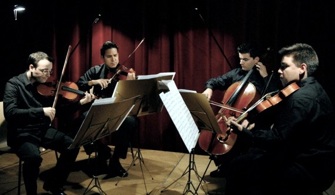|
|
>> Versão portuguesa |
| Tradition and Imagination VIRGÍLO MELO |
2012.01.25 |
|
In the delicate practice of critical discourse, and even in its more profound side of analytical discourse, it is not uncommon to use, somewhat recklessly and superficially some categorical vocabulary, which under a closer look, reveals itself as vague definitions; it is quite common to associate the term serial to “sawtooth” melodies and lack of repetition, the post-modern to referential juxtaposition of various pastiches, and so on. In the case of “Processione” by Eduardo Patriarca (born in 1970) such generalizations appear as slippery and counterproductive, all the more, since the composer has always affirmed himself as influenced by spectral aesthetics, which is usually connoted with a discourse of slow evolution and interleaving, occasionally stimulated by shocks as if they were transcriptions of a sound spectrum with the evolution of its harmonics and attack transients. Now, there is nothing more inadequate than to apply such images to describe the work of Patriarca. Despite the beginning with a locus classicus (harmonics of the cello’s lower C spectrum), the sinuousness of the following discourse is impressive and noteworthy both formally and through the sound variety. The game rule of the above-mentioned commissions was to base the works on a traditional Portuguese melody. In this case the composer chose a melody from Torres Novas entitled “Marcha dos Círios”, here presented in its modal colour and poetic resonances of its social function. Patriarca’s music achieves a notable technical malleability in working the melody’s presuppositions, allowing him to construct a refined discourse in the interpretation of expressive gestures, going from an original and expressive counterpoint, to a harmonic agitation of the detail, yet feeling to be governed by a slower evolution, to which a greater line is sustained. At the end, the mirror of the initial measures does not sound as mere symmetry, but likewise, reveals the traversed course in the term’s strongest sense. This excellent score, above everything all, appears to be prolific for future developments. The Second String Quartet in D minor by Luiz Costa (1879-1960), although written in 1930, is a recently discovered work under the good auspices of the musicologist Christine Wasermann Beirão, dedicated to the investigation of the composer’s legacy. Despite his notable musical personality in various aspects of his multiple activity, Luiz Costa, as composer, does not manage to surpass a distinct banality, within an aesthetics marked by an excessive attachment to tradition; the quartet is a series of pieces in which there is no manifestation neither of a sufficient development connected with the sonata form, nor, and this in spite of some timbrical investigation, sufficient creativity to transform them into pieces of successful character. Although stepping somewhat outside the thematic range of the New Music Review Lounge, I could not avoid mentioning the excellent interpretation, which the Matosinhos String Quartet gave to the Quartet no. 1 op. 20 by Joseph Haydn. Still, on the other hand, the inclusion of the classical master’s music allows me to emphasise one of the great lessons: in the monumental series of his sixty nine quartets dominates the imagination and the explicit willingness never to repeat formulas and solutions, no matter how successful they were in the past. Permanent questioning and search is one of the features of the European classical tradition, which makes it perennial. Of the two more contemporary composers present in the concert’s programme the one who respects more, loves and assimilates this tradition is, undoubtedly, the one whose sound universe appears, at first sight, more withdrawn from it. |
|
 The 2012 Matosinhos String Quartet Concert Season began on January 19 at the Cine-Teatro Constantino Nery. It will include premiere performances of three commissions of the Matosinhos Municipality to such composers as:
The 2012 Matosinhos String Quartet Concert Season began on January 19 at the Cine-Teatro Constantino Nery. It will include premiere performances of three commissions of the Matosinhos Municipality to such composers as: